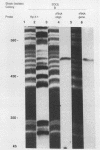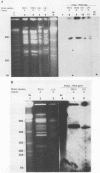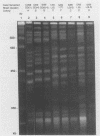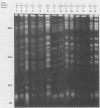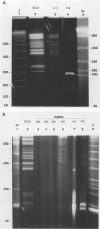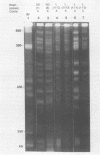Abstract
Pulsed-field gel electrophoresis techniques were used to examine the chromosomes of Pneumocystis carinii isolated from laboratory rats and two human subjects. P. carinii organisms isolated from each of four rat colonies and from two patients each produced a distinct band pattern, but in all cases the bands ranged in size from 300 to 700 kilobase pairs. P. carinii from three rat colonies produced patterns containing 15 prominent bands. Of these 15 bands, 2 stained more intensely than would be expected of bands of their size, suggesting that the P. carinii haploid genome contains 17 to 19 chromosomes. Summing the molecular sizes of the bands and accounting for staining intensities suggested that the haploid genome of rat-derived P. carinii contains on the order of 10(7) base pairs. Human-derived P. carinii produced patterns containing 10 to 12 bands which appeared to be similar to the 15-band patterns seen in rat-derived P. carinii with respect to the size range of the bands. P. carinii from the fourth rat colony produced a more complex band pattern containing approximately 22 bands, most of which appeared to comigrate with the bands present in one of the 15-band P. carinii patterns, suggesting that these animals were simultaneously infected by two different varieties of P. carinii. Hybridization experiments using oligonucleotide probes specific for the P. carinii 18S rRNA gene supported this possibility. The band pattern of P. carinii derived from a given rat colony was generally stable over time. P. carinii band patterns were not strictly rat strain specific and appeared to be transferrable between animals housed in the same room.
Full text
PDF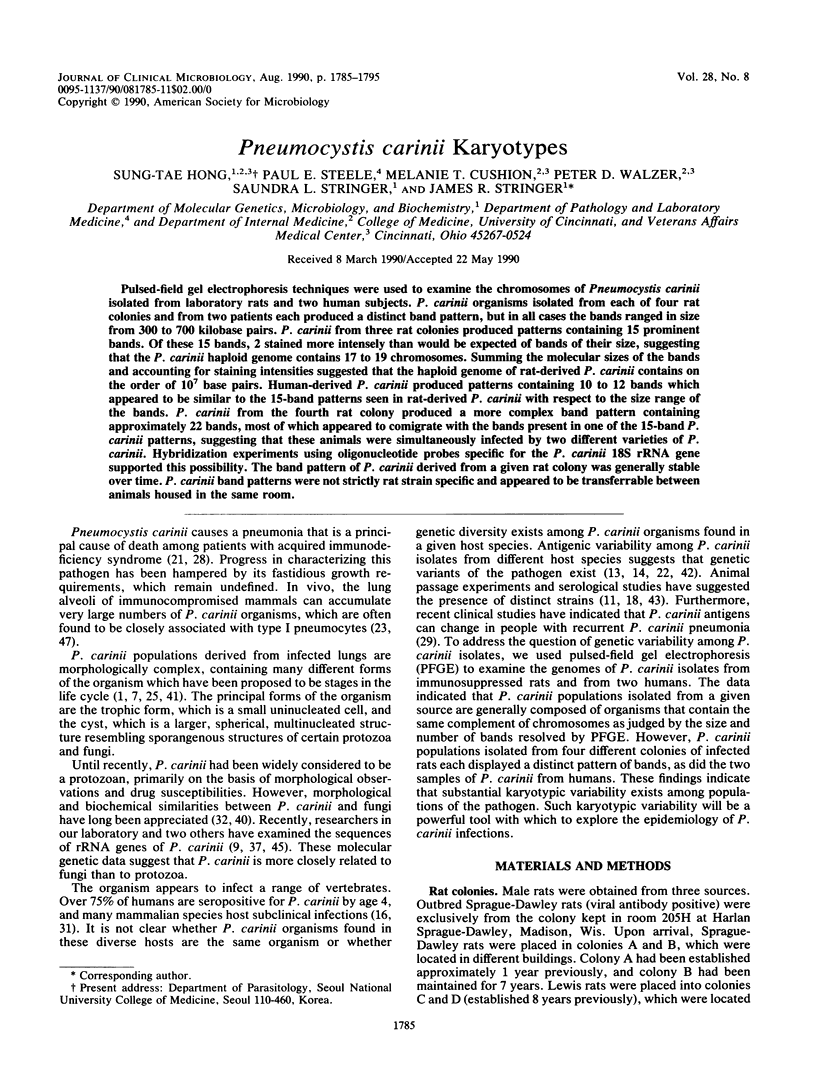
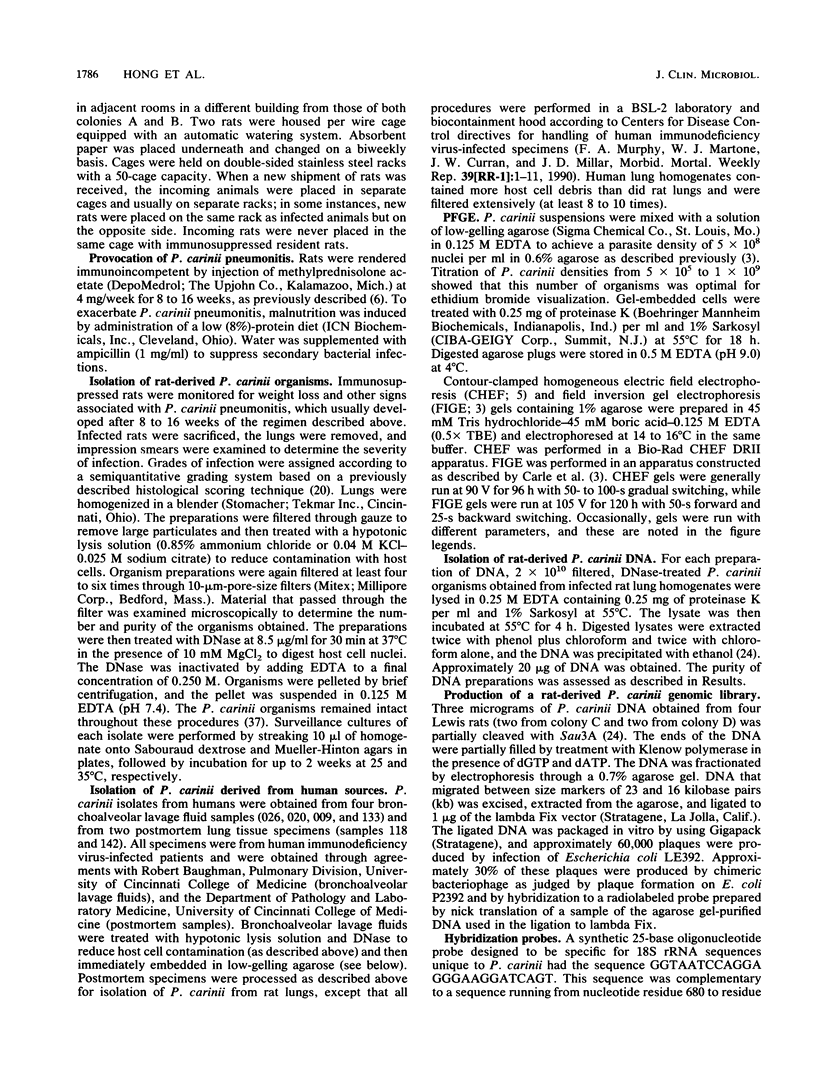
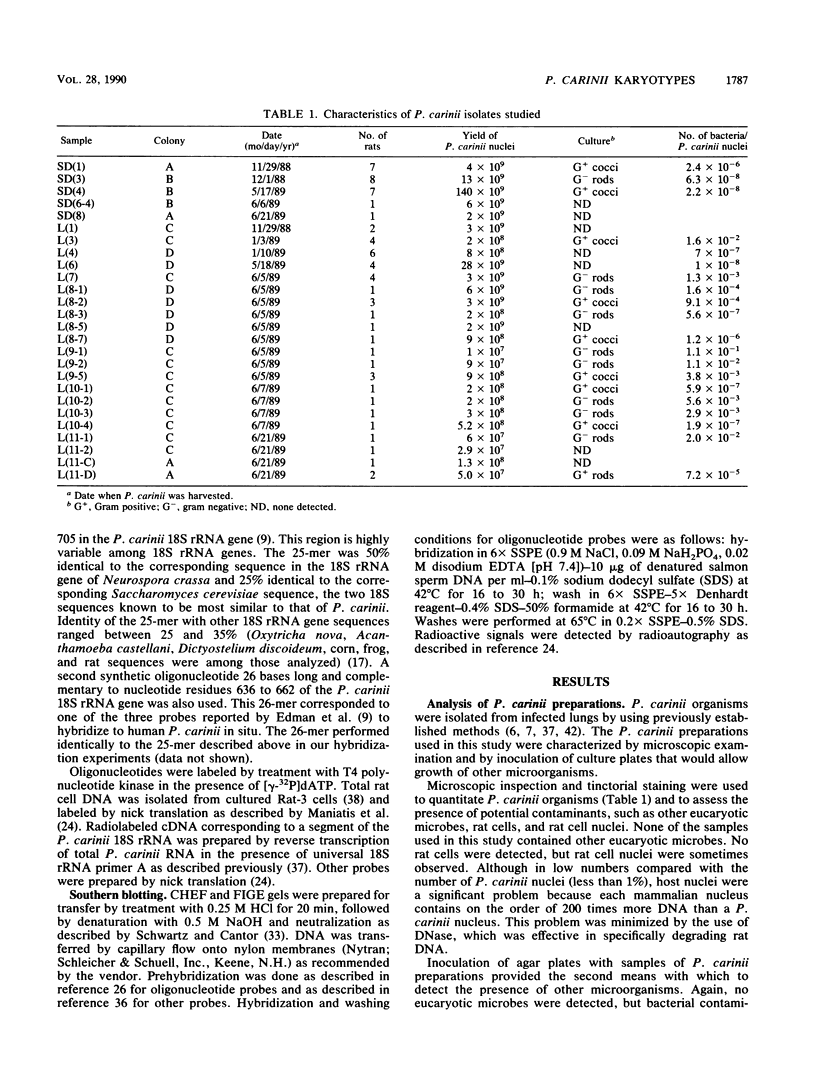
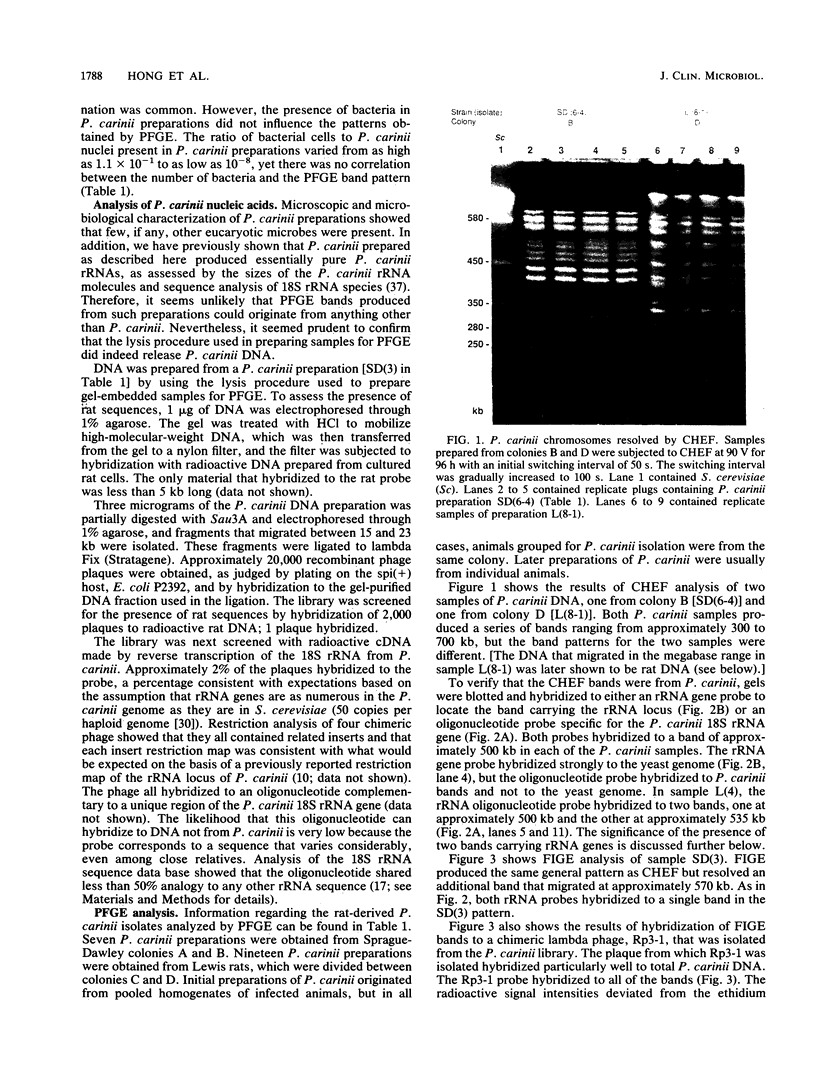
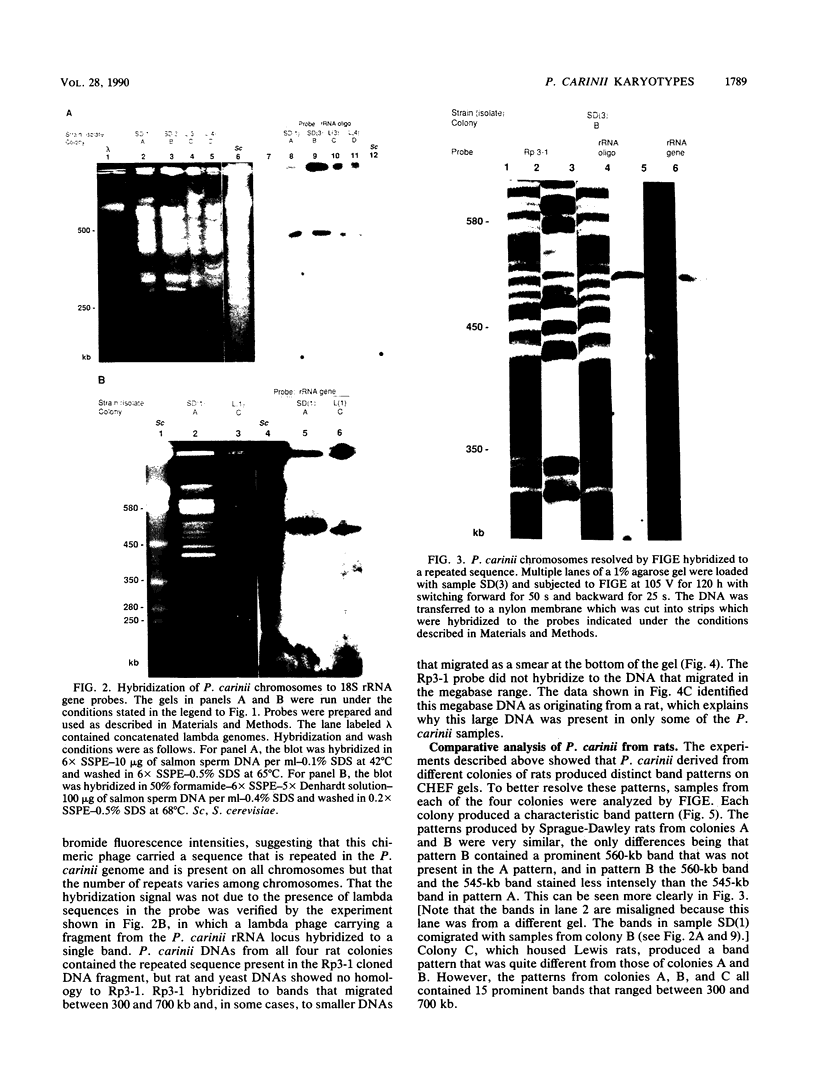
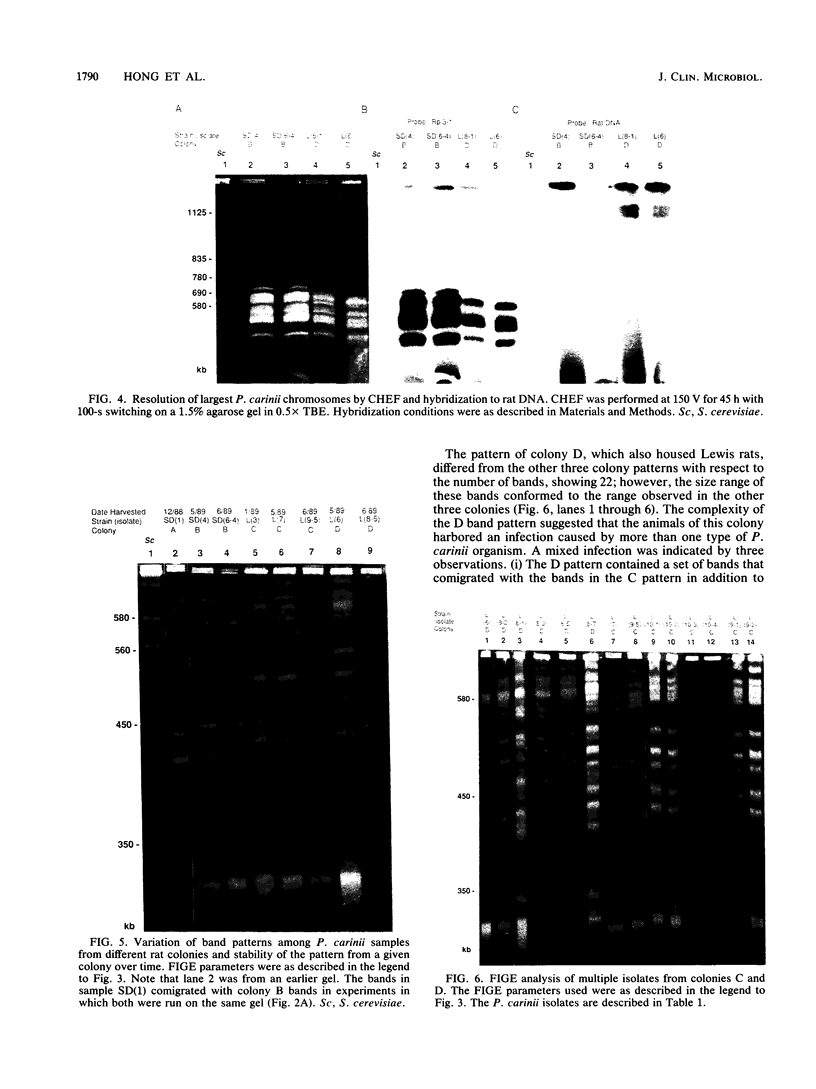
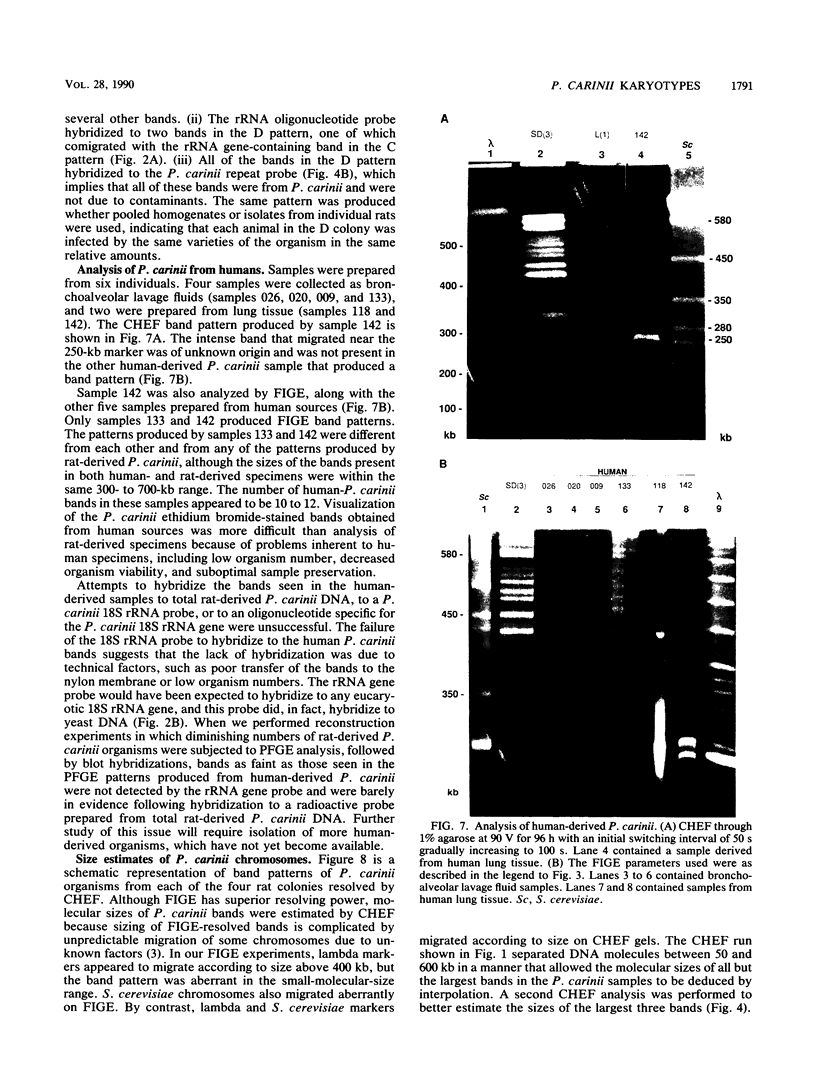
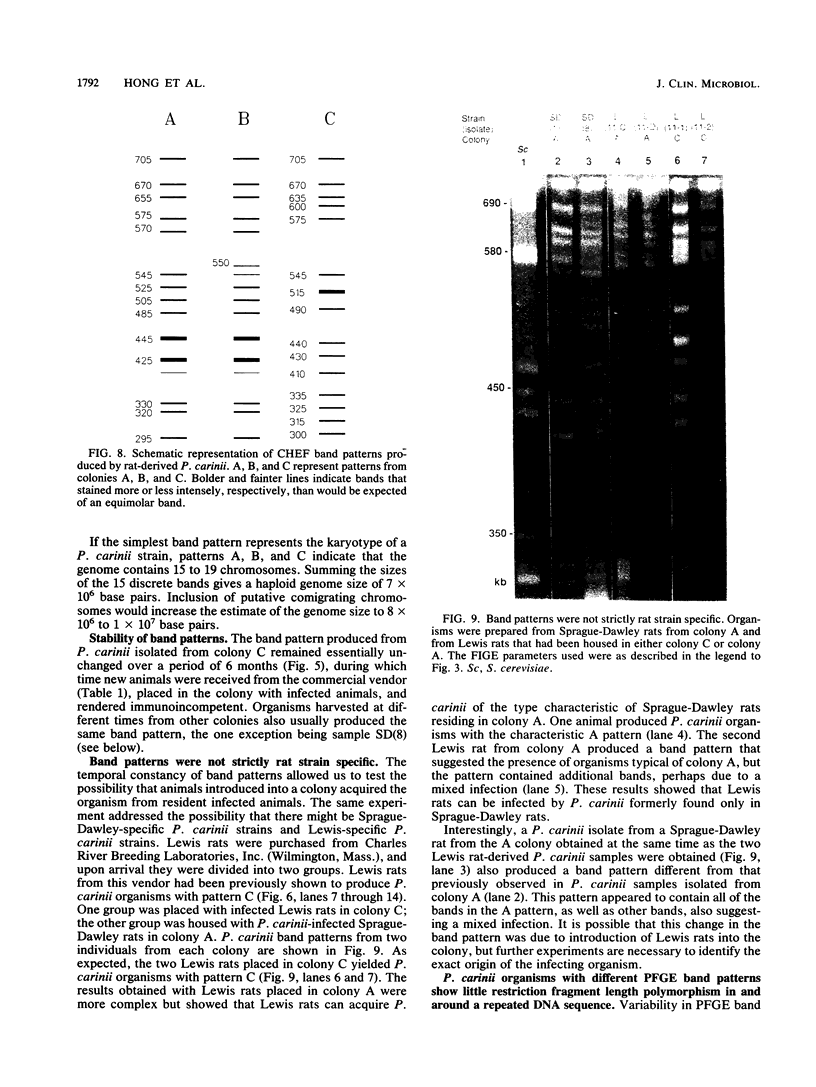
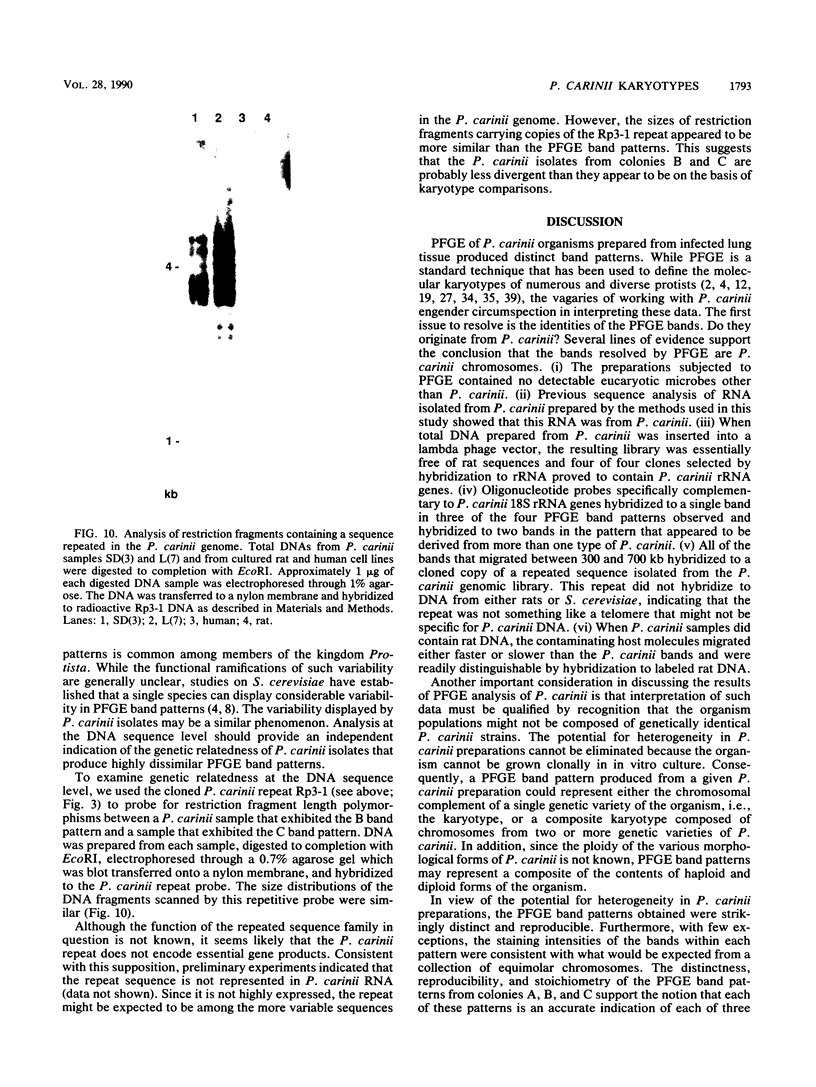
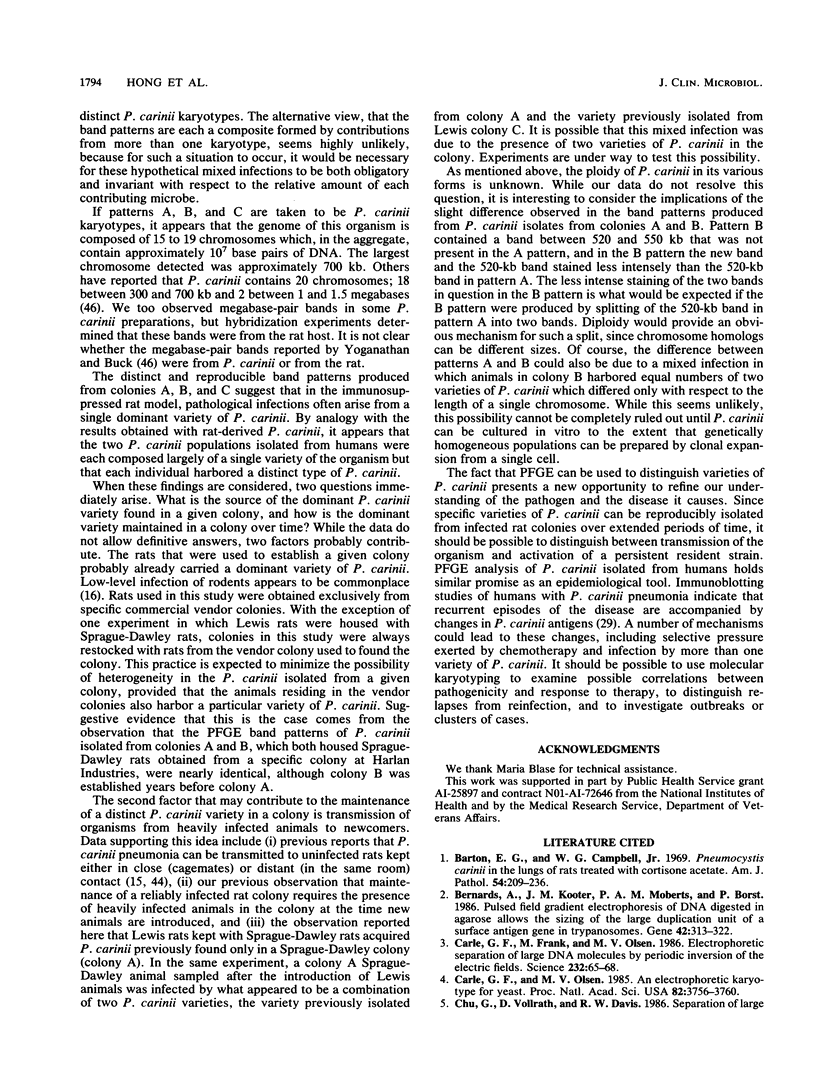
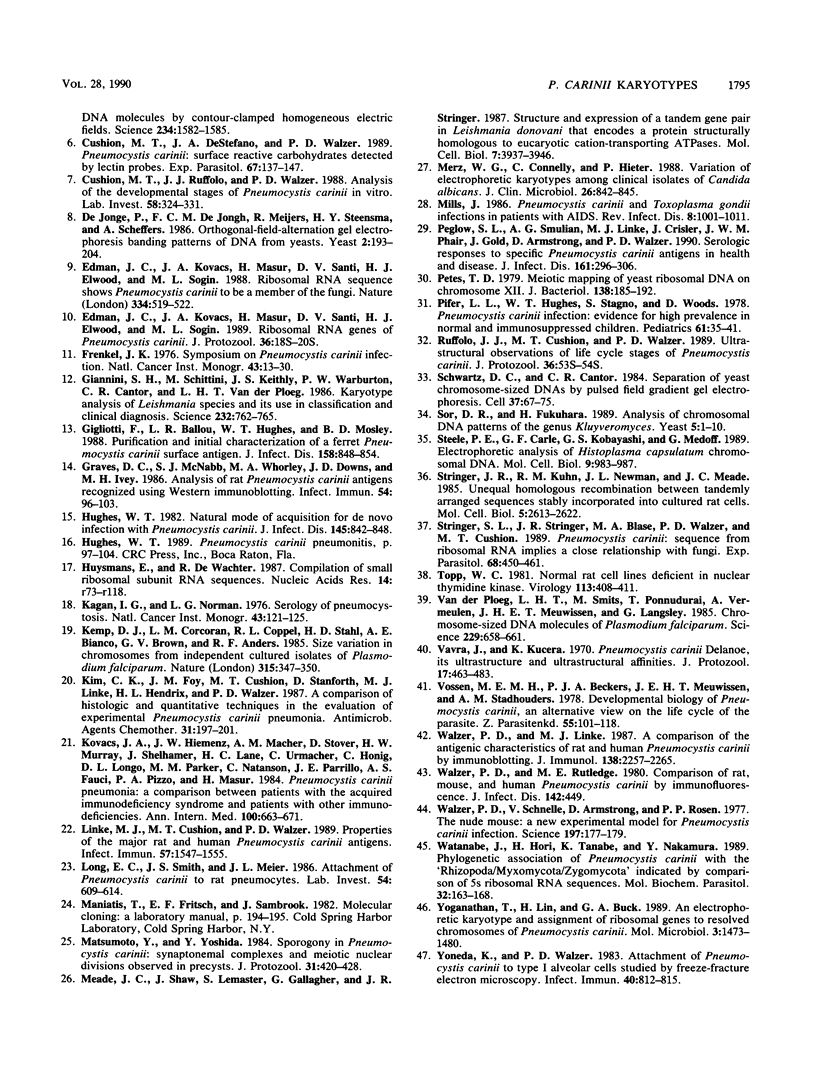
Images in this article
Selected References
These references are in PubMed. This may not be the complete list of references from this article.
- Barton E. G., Jr, Campbell W. G., Jr Pneumocystis carinii in lungs of rats treated with cortisone acetate. Ultrastructural observations relating to the life cycle. Am J Pathol. 1969 Feb;54(2):209–236. [PMC free article] [PubMed] [Google Scholar]
- Bernards A., Kooter J. M., Michels P. A., Moberts R. M., Borst P. Pulsed field gradient electrophoresis of DNA digested in agarose allows the sizing of the large duplication unit of a surface antigen gene in trypanosomes. Gene. 1986;42(3):313–322. doi: 10.1016/0378-1119(86)90235-0. [DOI] [PubMed] [Google Scholar]
- Carle G. F., Frank M., Olson M. V. Electrophoretic separations of large DNA molecules by periodic inversion of the electric field. Science. 1986 Apr 4;232(4746):65–68. doi: 10.1126/science.3952500. [DOI] [PubMed] [Google Scholar]
- Carle G. F., Olson M. V. An electrophoretic karyotype for yeast. Proc Natl Acad Sci U S A. 1985 Jun;82(11):3756–3760. doi: 10.1073/pnas.82.11.3756. [DOI] [PMC free article] [PubMed] [Google Scholar]
- Chu G., Vollrath D., Davis R. W. Separation of large DNA molecules by contour-clamped homogeneous electric fields. Science. 1986 Dec 19;234(4783):1582–1585. doi: 10.1126/science.3538420. [DOI] [PubMed] [Google Scholar]
- Cushion M. T., DeStefano J. A., Walzer P. D. Pneumocystis carinii: surface reactive carbohydrates detected by lectin probes. Exp Parasitol. 1988 Dec;67(2):137–147. doi: 10.1016/0014-4894(88)90061-6. [DOI] [PubMed] [Google Scholar]
- Cushion M. T., Ruffolo J. J., Walzer P. D. Analysis of the developmental stages of Pneumocystis carinii, in vitro. Lab Invest. 1988 Mar;58(3):324–331. [PubMed] [Google Scholar]
- Edman J. C., Kovacs J. A., Masur H., Santi D. V., Elwood H. J., Sogin M. L. Ribosomal RNA genes of Pneumocystis carinii. J Protozool. 1989 Jan-Feb;36(1):18S–20S. doi: 10.1111/j.1550-7408.1989.tb02672.x. [DOI] [PubMed] [Google Scholar]
- Edman J. C., Kovacs J. A., Masur H., Santi D. V., Elwood H. J., Sogin M. L. Ribosomal RNA sequence shows Pneumocystis carinii to be a member of the fungi. Nature. 1988 Aug 11;334(6182):519–522. doi: 10.1038/334519a0. [DOI] [PubMed] [Google Scholar]
- Frenkel J. K. Pneumocystis jiroveci n. sp. from man: morphology, physiology, and immunology in relation to pathology. Natl Cancer Inst Monogr. 1976 Oct;43:13–30. [PubMed] [Google Scholar]
- Giannini S. H., Schittini M., Keithly J. S., Warburton P. W., Cantor C. R., Van der Ploeg L. H. Karyotype analysis of Leishmania species and its use in classification and clinical diagnosis. Science. 1986 May 9;232(4751):762–765. doi: 10.1126/science.3961502. [DOI] [PubMed] [Google Scholar]
- Gigliotti F., Ballou L. R., Hughes W. T., Mosley B. D. Purification and initial characterization of a ferret Pneumocystis carinii surface antigen. J Infect Dis. 1988 Oct;158(4):848–854. doi: 10.1093/infdis/158.4.848. [DOI] [PubMed] [Google Scholar]
- Graves D. C., McNabb S. J., Worley M. A., Downs T. D., Ivey M. H. Analyses of rat Pneumocystis carinii antigens recognized by human and rat antibodies by using western immunoblotting. Infect Immun. 1986 Oct;54(1):96–103. doi: 10.1128/iai.54.1.96-103.1986. [DOI] [PMC free article] [PubMed] [Google Scholar]
- Hughes W. T. Natural mode of acquisition for de novo infection with Pneumocystis carinii. J Infect Dis. 1982 Jun;145(6):842–848. doi: 10.1093/infdis/145.6.842. [DOI] [PubMed] [Google Scholar]
- Huysmans E., De Wachter R. Compilation of small ribosomal subunit RNA sequences. Nucleic Acids Res. 1986;14 (Suppl):r73–118. doi: 10.1093/nar/14.suppl.r73. [DOI] [PMC free article] [PubMed] [Google Scholar]
- Kagan I. G., Norman L. G. Serology of pneumocystosis. Natl Cancer Inst Monogr. 1976 Oct;43:121–125. [PubMed] [Google Scholar]
- Kemp D. J., Corcoran L. M., Coppel R. L., Stahl H. D., Bianco A. E., Brown G. V., Anders R. F. Size variation in chromosomes from independent cultured isolates of Plasmodium falciparum. Nature. 1985 May 23;315(6017):347–350. doi: 10.1038/315347a0. [DOI] [PubMed] [Google Scholar]
- Kim C. K., Foy J. M., Cushion M. T., Stanforth D., Linke M. J., Hendrix H. L., Walzer P. D. Comparison of histologic and quantitative techniques in evaluation of therapy for experimental Pneumocystis carinii pneumonia. Antimicrob Agents Chemother. 1987 Feb;31(2):197–201. doi: 10.1128/aac.31.2.197. [DOI] [PMC free article] [PubMed] [Google Scholar]
- Kovacs J. A., Hiemenz J. W., Macher A. M., Stover D., Murray H. W., Shelhamer J., Lane H. C., Urmacher C., Honig C., Longo D. L. Pneumocystis carinii pneumonia: a comparison between patients with the acquired immunodeficiency syndrome and patients with other immunodeficiencies. Ann Intern Med. 1984 May;100(5):663–671. doi: 10.7326/0003-4819-100-5-663. [DOI] [PubMed] [Google Scholar]
- Linke M. J., Cushion M. T., Walzer P. D. Properties of the major antigens of rat and human Pneumocystis carinii. Infect Immun. 1989 May;57(5):1547–1555. doi: 10.1128/iai.57.5.1547-1555.1989. [DOI] [PMC free article] [PubMed] [Google Scholar]
- Long E. G., Smith J. S., Meier J. L. Attachment of Pneumocystis carinii to rat pneumocytes. Lab Invest. 1986 Jun;54(6):609–615. [PubMed] [Google Scholar]
- Matsumoto Y., Yoshida Y. Sporogony in Pneumocystis carinii: synaptonemal complexes and meiotic nuclear divisions observed in precysts. J Protozool. 1984 Aug;31(3):420–428. doi: 10.1111/j.1550-7408.1984.tb02989.x. [DOI] [PubMed] [Google Scholar]
- Meade J. C., Shaw J., Lemaster S., Gallagher G., Stringer J. R. Structure and expression of a tandem gene pair in Leishmania donovani that encodes a protein structurally homologous to eucaryotic cation-transporting ATPases. Mol Cell Biol. 1987 Nov;7(11):3937–3946. doi: 10.1128/mcb.7.11.3937. [DOI] [PMC free article] [PubMed] [Google Scholar]
- Merz W. G., Connelly C., Hieter P. Variation of electrophoretic karyotypes among clinical isolates of Candida albicans. J Clin Microbiol. 1988 May;26(5):842–845. doi: 10.1128/jcm.26.5.842-845.1988. [DOI] [PMC free article] [PubMed] [Google Scholar]
- Mills J. Pneumocystis carinii and Toxoplasma gondii infections in patients with AIDS. Rev Infect Dis. 1986 Nov-Dec;8(6):1001–1011. doi: 10.1093/clinids/8.6.1001. [DOI] [PubMed] [Google Scholar]
- Peglow S. L., Smulian A. G., Linke M. J., Pogue C. L., Nurre S., Crisler J., Phair J., Gold J. W., Armstrong D., Walzer P. D. Serologic responses to Pneumocystis carinii antigens in health and disease. J Infect Dis. 1990 Feb;161(2):296–306. doi: 10.1093/infdis/161.2.296. [DOI] [PubMed] [Google Scholar]
- Petes T. D. Meiotic mapping of yeast ribosomal deoxyribonucleic acid on chromosome XII. J Bacteriol. 1979 Apr;138(1):185–192. doi: 10.1128/jb.138.1.185-192.1979. [DOI] [PMC free article] [PubMed] [Google Scholar]
- Pifer L. L., Hughes W. T., Stagno S., Woods D. Pneumocystis carinii infection: evidence for high prevalence in normal and immunosuppressed children. Pediatrics. 1978 Jan;61(1):35–41. [PubMed] [Google Scholar]
- Ruffolo J. J., Cushion M. T., Walzer P. D. Ultrastructural observations on life cycle stages of Pneumocystis carinii. J Protozool. 1989 Jan-Feb;36(1):53S–54S. doi: 10.1111/j.1550-7408.1989.tb02697.x. [DOI] [PubMed] [Google Scholar]
- Schwartz D. C., Cantor C. R. Separation of yeast chromosome-sized DNAs by pulsed field gradient gel electrophoresis. Cell. 1984 May;37(1):67–75. doi: 10.1016/0092-8674(84)90301-5. [DOI] [PubMed] [Google Scholar]
- Sor F., Fukuhara H. Analysis of chromosomal DNA patterns of the genus Kluyveromyces. Yeast. 1989 Jan-Feb;5(1):1–10. doi: 10.1002/yea.320050103. [DOI] [PubMed] [Google Scholar]
- Steele P. E., Carle G. F., Kobayashi G. S., Medoff G. Electrophoretic analysis of Histoplasma capsulatum chromosomal DNA. Mol Cell Biol. 1989 Mar;9(3):983–987. doi: 10.1128/mcb.9.3.983. [DOI] [PMC free article] [PubMed] [Google Scholar]
- Stringer J. R., Kuhn R. M., Newman J. L., Meade J. C. Unequal homologous recombination between tandemly arranged sequences stably incorporated into cultured rat cells. Mol Cell Biol. 1985 Oct;5(10):2613–2622. doi: 10.1128/mcb.5.10.2613. [DOI] [PMC free article] [PubMed] [Google Scholar]
- Stringer S. L., Stringer J. R., Blase M. A., Walzer P. D., Cushion M. T. Pneumocystis carinii: sequence from ribosomal RNA implies a close relationship with fungi. Exp Parasitol. 1989 May;68(4):450–461. doi: 10.1016/0014-4894(89)90130-6. [DOI] [PubMed] [Google Scholar]
- Topp W. C. Normal rat cell lines deficient in nuclear thymidine kinase. Virology. 1981 Aug;113(1):408–411. doi: 10.1016/0042-6822(81)90168-9. [DOI] [PubMed] [Google Scholar]
- Van der Ploeg L. H., Smits M., Ponnudurai T., Vermeulen A., Meuwissen J. H., Langsley G. Chromosome-sized DNA molecules of Plasmodium falciparum. Science. 1985 Aug 16;229(4714):658–661. doi: 10.1126/science.3895435. [DOI] [PubMed] [Google Scholar]
- Vavra J., Kucera K. Pneumocystis carinii delanoë, its ultrastructure and ultrastructural affinities. J Protozool. 1970 Aug;17(3):463–483. doi: 10.1111/j.1550-7408.1970.tb04715.x. [DOI] [PubMed] [Google Scholar]
- Vossen M. E., Beckers P. J., Meuwissen J. H., Stadhouders A. M. Developmental biology of Pneumocystis carinii, and alternative view on the life cycle of the parasite. Z Parasitenkd. 1978 Apr 20;55(2):101–118. doi: 10.1007/BF00384826. [DOI] [PubMed] [Google Scholar]
- Walzer P. D., Linke M. J. A comparison of the antigenic characteristics of rat and human Pneumocystis carinii by immunoblotting. J Immunol. 1987 Apr 1;138(7):2257–2265. [PubMed] [Google Scholar]
- Walzer P. D., Rutledge M. E. Comparison of rat, mouse, and human Pneumocystis carinii by immunofluorescence. J Infect Dis. 1980 Sep;142(3):449–449. doi: 10.1093/infdis/142.3.449. [DOI] [PubMed] [Google Scholar]
- Walzer P. D., Schnelle V., Armstrong D., Rosen P. P. Nude mouse: a new experimental model for Pneumocystis carinii infection. Science. 1977 Jul 8;197(4299):177–179. doi: 10.1126/science.301657. [DOI] [PubMed] [Google Scholar]
- Watanabe J., Hori H., Tanabe K., Nakamura Y. Phylogenetic association of Pneumocystis carinii with the 'Rhizopoda/Myxomycota/Zygomycota group' indicated by comparison of 5S ribosomal RNA sequences. Mol Biochem Parasitol. 1989 Jan 15;32(2-3):163–167. doi: 10.1016/0166-6851(89)90067-4. [DOI] [PubMed] [Google Scholar]
- Yoganathan T., Lin H., Buck G. A. An electrophoretic karyotype and assignment of ribosomal genes to resolved chromosomes of Pneumocystis carinii. Mol Microbiol. 1989 Nov;3(11):1473–1480. doi: 10.1111/j.1365-2958.1989.tb00132.x. [DOI] [PubMed] [Google Scholar]
- Yoneda K., Walzer P. D. Attachment of Pneumocystis carinii to type I alveolar cells studied by freeze-fracture electron microscopy. Infect Immun. 1983 May;40(2):812–815. doi: 10.1128/iai.40.2.812-815.1983. [DOI] [PMC free article] [PubMed] [Google Scholar]
- de Jonge P., de Jongh F. C., Meijers R., Steensma H. Y., Scheffers W. A. Orthogonal-field-alternation gel electrophoresis banding patterns of DNA from yeasts. Yeast. 1986 Sep;2(3):193–204. doi: 10.1002/yea.320020307. [DOI] [PubMed] [Google Scholar]




